Rennie Scaysbrook | September 1, 2019
2018 Suzuki GSX-R1000R Long Term Review
Living with a Bi-Polar
The flagship bike in Suzuki’s superbike lineup is designed purely for the track. Or so they say.
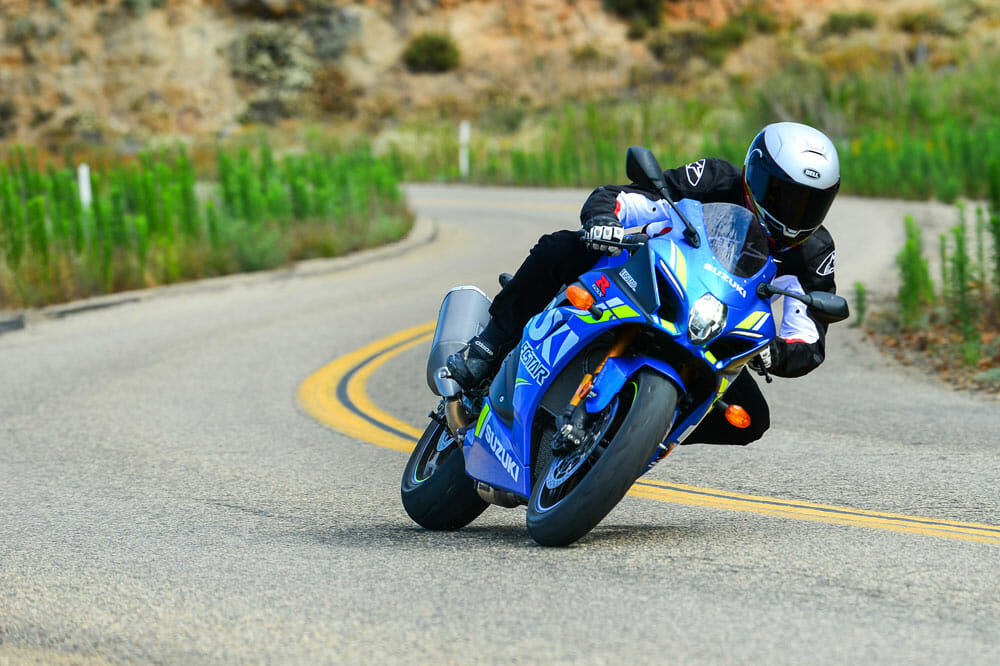 As a weekend canyon warrior, the GSX-R has few peers.
As a weekend canyon warrior, the GSX-R has few peers.
I awoke one Wednesday morning rather bemused. It’d been years since I’d spent any great deal of time with a superbike in my garage, and I must admit, I felt slightly emasculated.
Had I simply outgrown superbike street riding? Surely I wasn’t that old. There had to be a touch of lunacy left in my loins.
Therefore, a seed planted in my brain. I’d take this, the Suzuki GSX-R1000R, and pit it against a Kawasaki ZX-10RR. These two have been slugging it out on racetracks since they both arrived on the scene a couple of years ago, so I figured it’d be good to see what’s what in SoCal.
But there was no Kawasaki available. Not at least until I was a few months deep with the Suzuki and the 900 other things I was doing took precedence.
Okay—so a long-term Suzuki test it became.
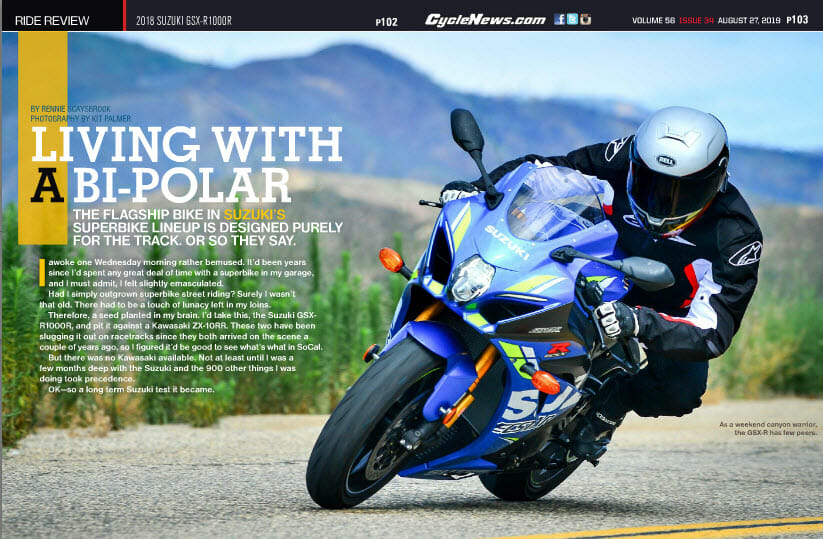
Photography by Kit Palmer
And I’m all the happier for it because living with a GSX-R1000R has rekindled my love of superbikes on the street.
The GSX-R1000R is one of those machines that reveals itself like an onion, showing off a new layer to its personality the longer you spend with it. Like a good girlfriend, most of the personality traits were welcome, occasionally there’d be things that’d get up my nose, but for the most part, Suzi and I got along swimmingly.
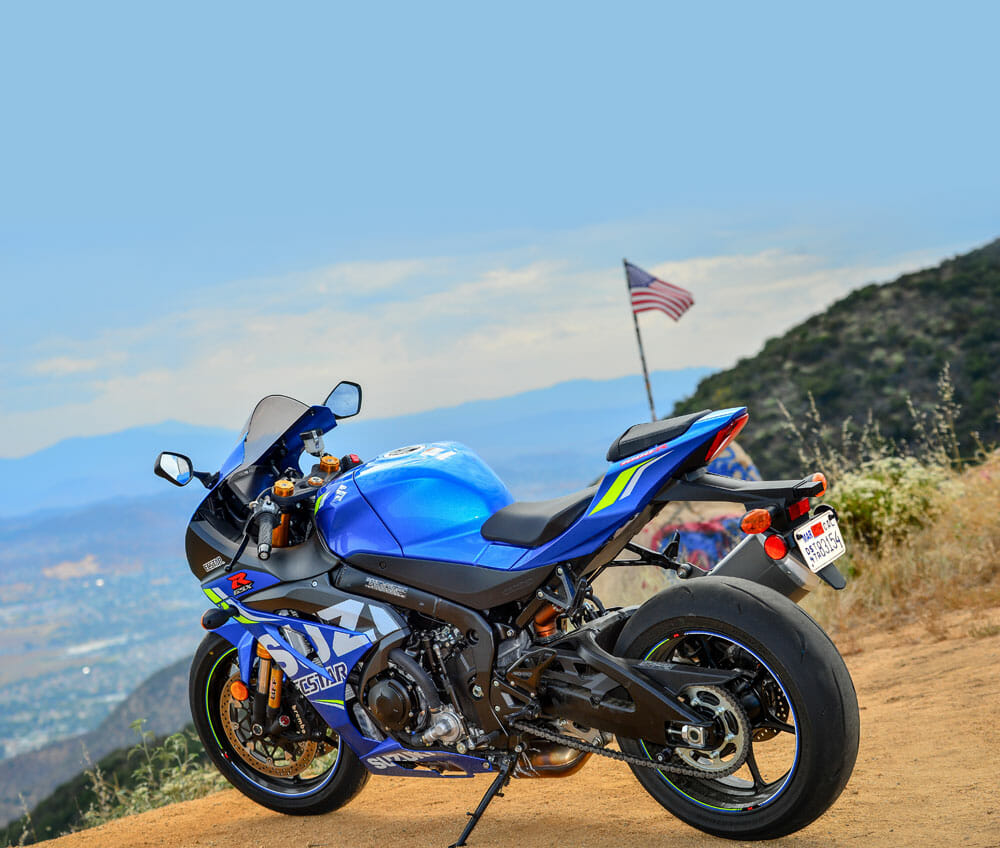 Because, America!
Because, America!
Before I begin, I must qualify this test by saying it’s not an out and out performance shootout.
I used the GSX-R as my daily rider for five months, taking it to product intros, going for late-night jaunts into Los Angeles, beach cruises for early morning croissants, a couple of track days, even bringing it to my son’s daycare a few times so he and the other little lads could get all gee’d up at the sights and sounds of the blue “sooki momo,” as he calls it.
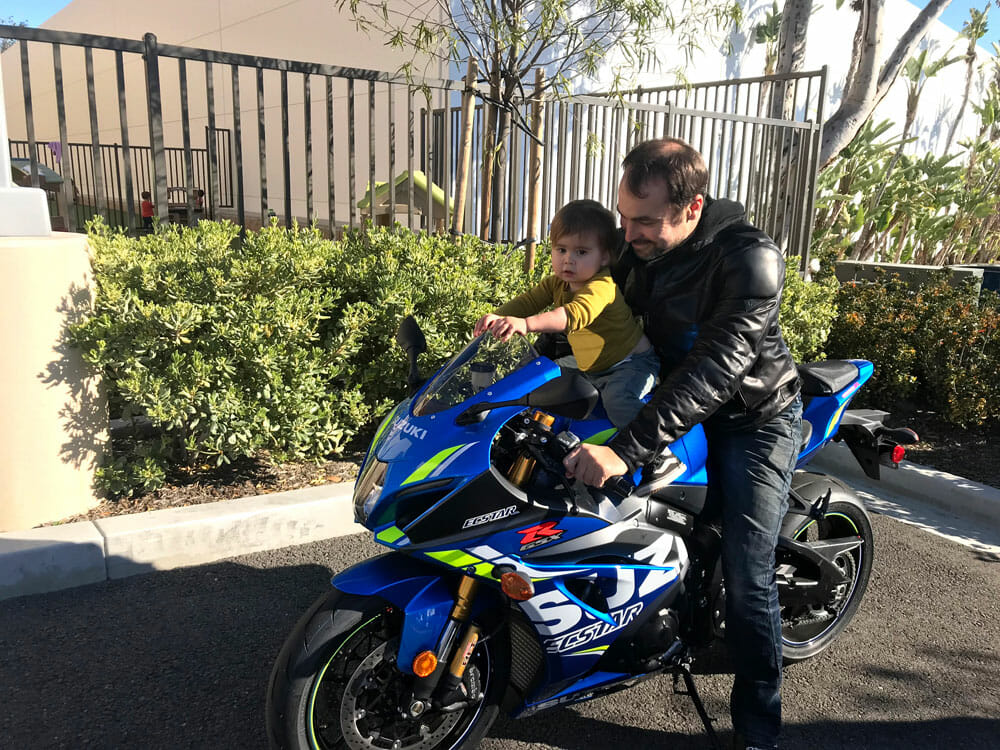 The blue and yellow Sooki proved a massive hit with the junior Scaysbrook.
The blue and yellow Sooki proved a massive hit with the junior Scaysbrook.
Even though this is a 2018 model, that doesn’t mean you cannot purchase one at your local Suzuki dealer. In fact, it’s the only GSX-R1000R you can buy in America, as the 2019 edition still isn’t here yet due to complications with the factory.
These 2019 bikes are due to arrive by September, and they come with the added benefit of making the 2018 a run-out model. That means there should be some very tasty 2018 deals floating around if you don’t care about the adjustable swingarm pivot, the stainless-steel brake lines, or the black muffler that replaces this horrid light silver unit.
Besides, go fit some Goodridge (or the like) brake lines and a Yoshimura pipe, and you’ve got 2/3 of a 2019 model, anyway. And if you need an adjustable swingarm pivot for your street bike, you should probably be looking to race at the Isle of Man.
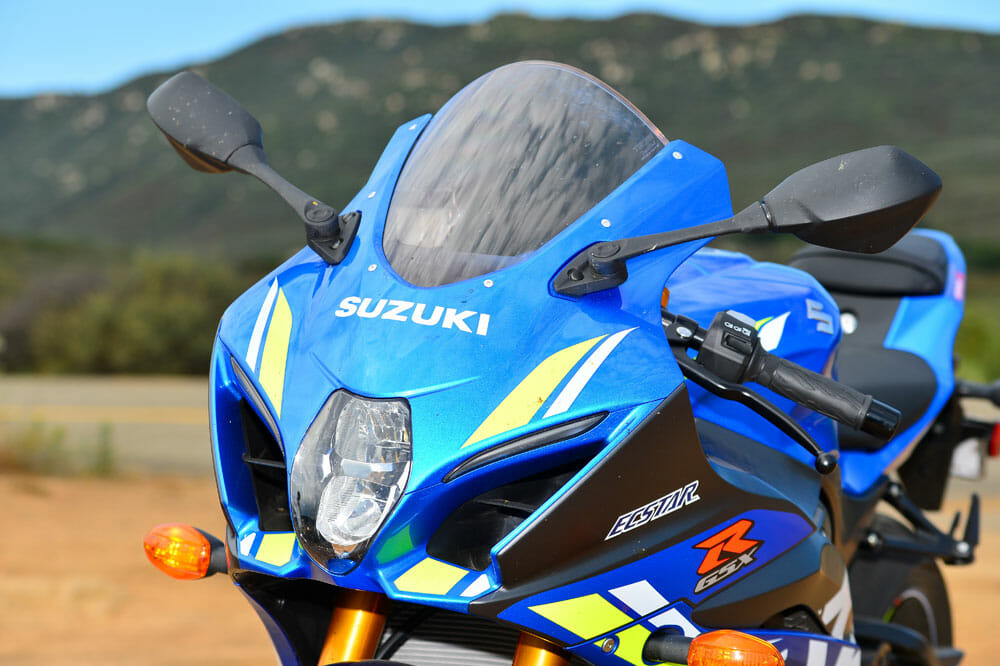 Suzuki’s minimalist front end is one of the cleanest in the current superbike game.
Suzuki’s minimalist front end is one of the cleanest in the current superbike game.
Modern superbikes are absolutely the most bi-polar machines with license plates you can buy. If you think about it, almost anything that produces the kind of performance a 1000R does on the street has to be operated on the wrong side of the law, but you don’t have to be that guy on the Suzuki.
Call it bi-polar, Jekyll and Hyde, whatever, the fact is at low rpm, the GSX-R is a pussycat. It’s superbly smooth when cruising in 405 traffic, although from closed throttle, the response at the twist grip can be a little twitchy. Anything below 9000 rpm on this thing is a breeze, especially when matched to that delightful up and down quickshifter on the six-speed gearbox.
Notch it above that 9k mark, however, and things happen very, very quickly.
At 10,000 rpm, that’s the point where the Suzuki Racing Variable Valve Timing (SR-VVT) system kicks in—Suzuki’s mechanical system that splits the camshaft sprocket into two halves, with one half carrying the sprocket itself, the other attaching to the camshaft, allowing for four degrees of rotation between the two pieces.
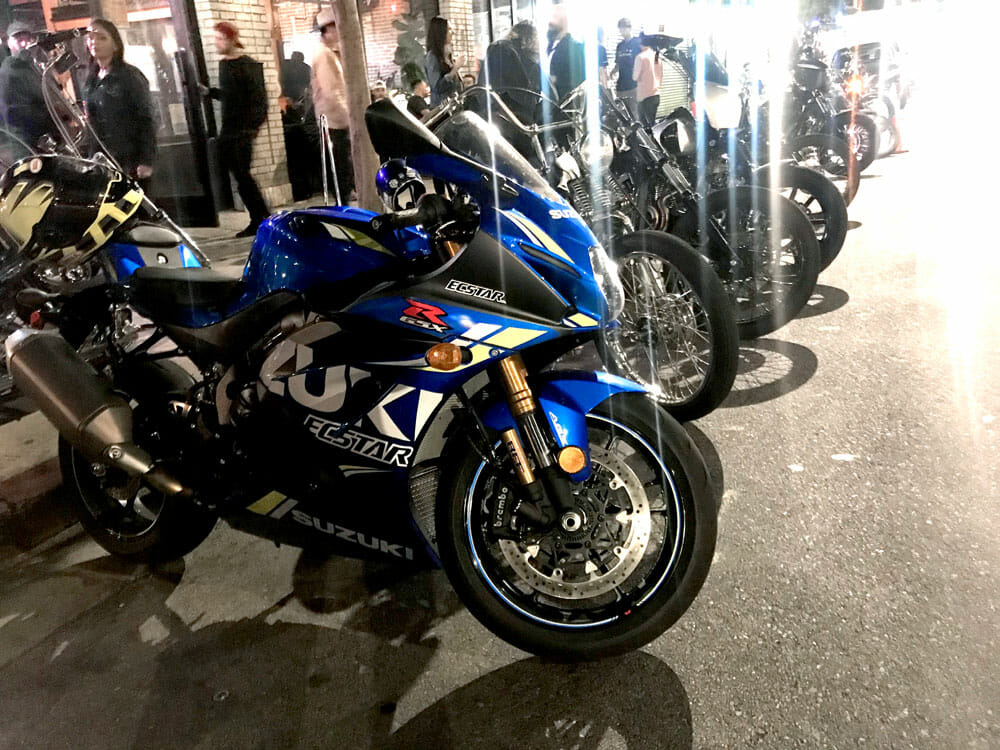 Take a GSX-R1000R to a hipster Harley night, and you soon realize you may be different from other people.
Take a GSX-R1000R to a hipster Harley night, and you soon realize you may be different from other people.
On the inside of both faces are radial grooves that house 12 steel balls and as the revs rise, centrifugal force pushes the balls outwards, up the grooves and varies the cam timing. The result is a noticeable kick in the power as the 1000R blasts out of the mid-range and into the top end.
On the track, this is pure lap time heaven, because even though the rush is noticeable, the motor is very linear in how it delivers power to the rear tire. It’s still a GSX-R in that it revs its nuts off with most of the power up top (in this case a redline of 14,500 rpm), but it has more of everything below that 10k rpm mark, making it a much more livable street bike.
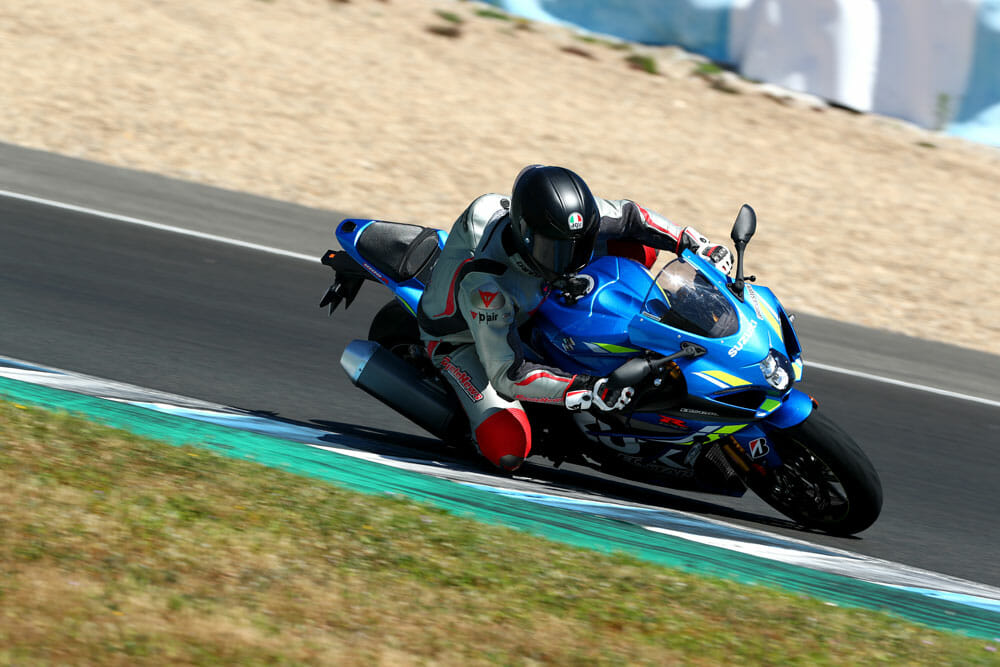 Chasing lap times on the GSX-R. You better have a few spare rear tires handy!
Chasing lap times on the GSX-R. You better have a few spare rear tires handy!
On the safety side, Suzuki has a six-axis Inertial Measurement Unit—pitch up and down, roll left and right, and yaw left and right—and communicates that information to the ECM to determine the intervention of traction and wheelie control.
Traction control is a 10-stage system with nine levels plus Off that takes in inputs from the Throttle Position Sensor, Acceleration Position Sensor, IMU, ECM, front and rear wheel speed sensors, Gear Position Sensor and the Crank Position Sensor to determine if you’re about to hit the deck, and if you have the system on level two as I did for almost the entire five months the GSX-R was in my garage, you forget the system is even working in the background. It’s a seamless TC, one aided by a chassis that has such great mechanical grip it takes the strain off the electronics.
The 1000R gets the extra funky Showa Balance Free Front fork and Balance Free Rear Cushion Lite shock compared to the base model’s Showa Big Piston Front fork plus Showa shock, and even though they are tuned more for racetrack performance than the street, on the latter, the performance is excellent. These are not electronically-adjustable units like on the BMW S 1000 RR or the Honda CBR1000RR SP, instead of relying on solid analog know-how to get the best set up. And it works. On the street, the 1000R is a gem to behold, especially when carving between cars and dodging potholes. The shock performs exceptionally well, deflecting high-speed compression jolts easily before the majority of the shock hits my butt.
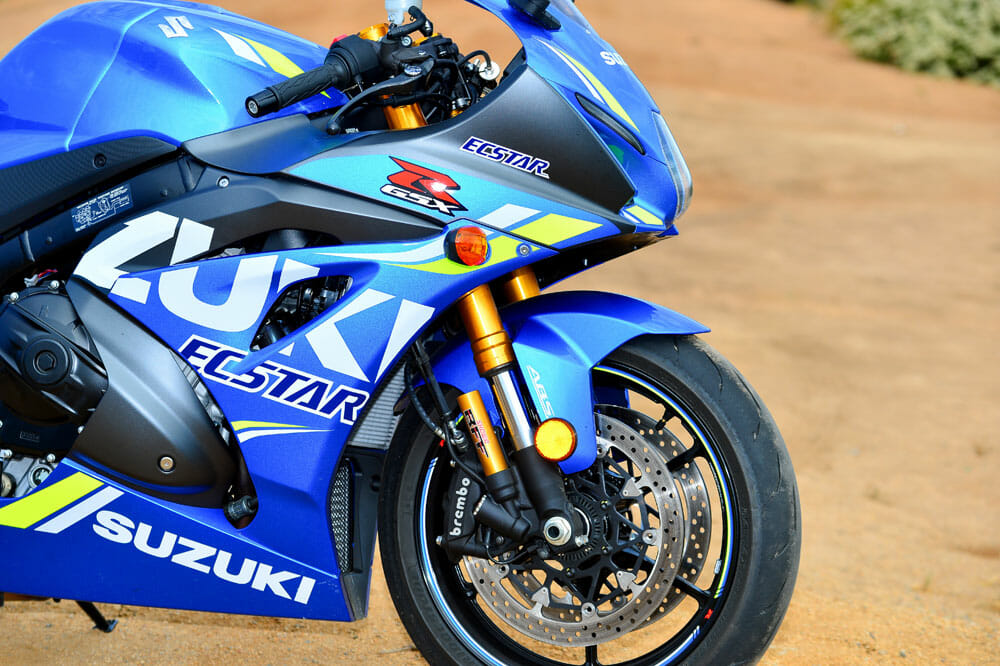 That Showa BFF fork is absolutely superb on the street.
That Showa BFF fork is absolutely superb on the street.
Performance-wise, the 1000R will hold a candle to any superbike in its class on the street. There’s more than enough power to send you to the big house very quickly, enough tech to keep you somewhat safe and the chassis is a scalpel when used in the canyons surrounding the greater LA area. And that induction roar under hard acceleration is the kind of stuff dreams are made of.
However, there are things dreadfully annoying with the 1000R if all you want is a fast street bike that will never see a track.
The first (and most important) is the lack of cruise control. For a premium product of $17,199, regardless of if it’s aimed more at track riding, it should come with cruise control. It has every electronic bell and whistle, so fitting a cruise-control system should not be an expense for Suzuki. Come to think of it, the base model doesn’t either.
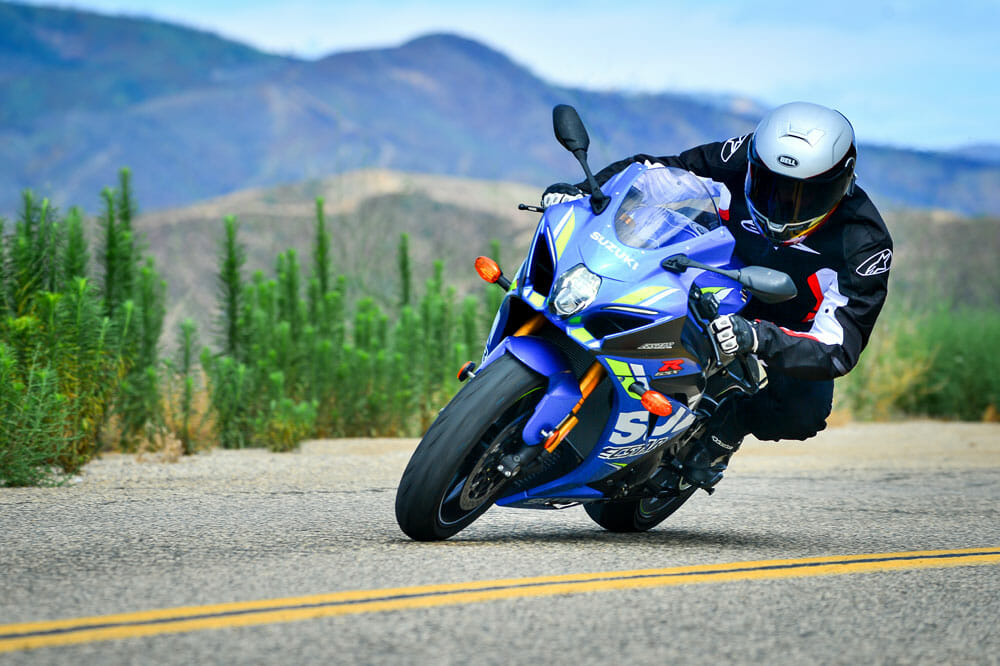 It’s sad to see the Suzi heading back, but thanks for rekindling the love of street superbike riding!
It’s sad to see the Suzi heading back, but thanks for rekindling the love of street superbike riding!
The rearset footpegs don’t give that feeling of solidity the rest of the bike does. They have a flimsy feel, and I’d love Suzuki to come out with thicker footpegs on this particular GSX-R in the future. Ergonomically speaking, the 1000R isn’t too bad given its objective, and that’s to be a bullet-fast superbike. You have the head down/bum up style, but it’s not as bad as something like a ZX-10R. I’d have liked the bars to be a touch wider, however, just to give my arms a bit of a break while doing the 405 run.
As for the dash, it’s now close to the worst dash in the current superbike class. It has a cheap feel and looks like a relic from the Gameboy era despite having in some cases more adjustment than others in the class.
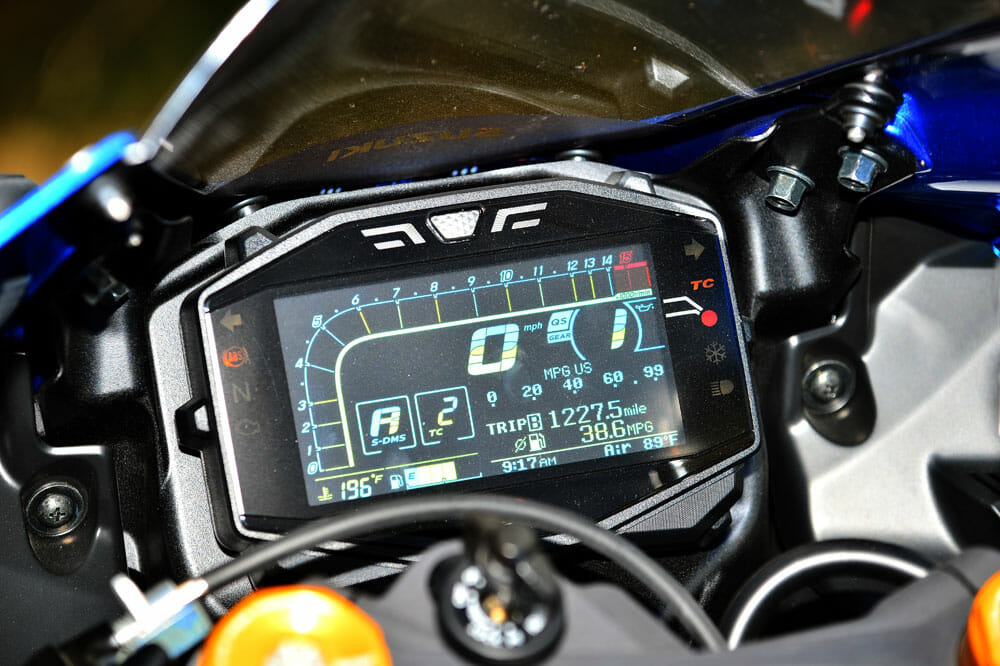 The dash is a relic from the pre-plasma TV age. Time to upgrade, Suzuki.
The dash is a relic from the pre-plasma TV age. Time to upgrade, Suzuki.
With that being said, the dash is easy to adjust via the large left switch block, but in this day of color LED screens on bikes costing far less than this, Suzuki needs to rectify this to give the 1000R a more premium feel.
Another thing with the electronics is the wheelie control, and TC is in the same algorithm, much like the 2017-2018 Honda CBR1000RR SP. This is fine, for the most part, however, on the few track days I had with the 1000R, I’d have loved this to be a split system, to let me carry a floating wheelie out of corners without the TC telling me “no!”.
I won’t crap on about the size of the muffler on this 2018 edition. Suzuki has come out with a slimmer, black version (black is slimming, right?) on the 2019 1000R, plus I’d want more noise anyway so the muffler would be the first thing I’d throw out.
There is also a surprising amount of heat that comes off the 1000R in traffic. Everything is incredibly tightly packed, but I don’t remember the last time a Japanese bike radiated this much heat while in traffic at a standstill. Once you’re moving, everything is sweet, but hot days and traffic are the absolute enemies of this bike.
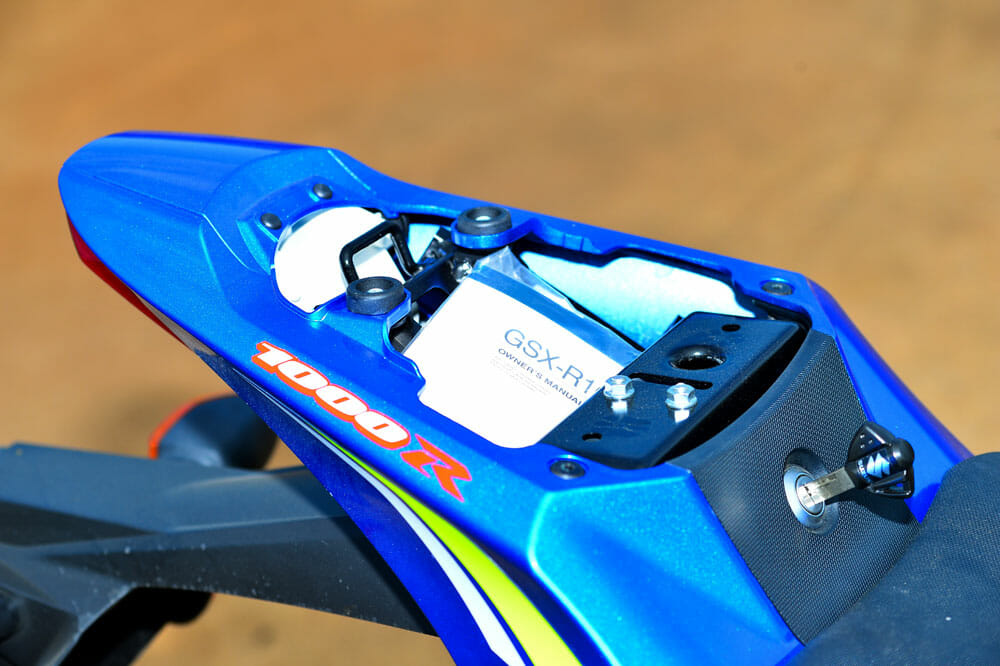 Storage for your adventure on the GSX-R1000R leaves a lot… actually, there’s no storage at all to speak of.
Storage for your adventure on the GSX-R1000R leaves a lot… actually, there’s no storage at all to speak of.
Fuel consumption was pretty good for a bike with a 4.2-gallon tank. I averaged around 30 mpg, which would give me between 120-130 miles depending on how much of a bonehead I was being with the throttle. Not bad for a superbike, but not great, either.
The GSX-R1000R and I had a good time together over our five-month relationship. It’s a superbly packaged machine, and aside from those few gripes, I just mentioned a competent road machine. It’s also quite well priced when you consider the top line BMW S 1000 RR M-Sport and Honda CBR1000RR SP superbikes are nearly $8000 more, and in line with the Yamaha YZF-R1M (which is $200 more), and $1600 cheaper than the Kawasaki ZX-10RR.
Insurance costs should be the same across any of these missiles, so what it comes down to is how you like your poison. If it’s blue and fluro yellow and loves a good dine at the rev bar, Suzuki has a proper weapon for you.CN
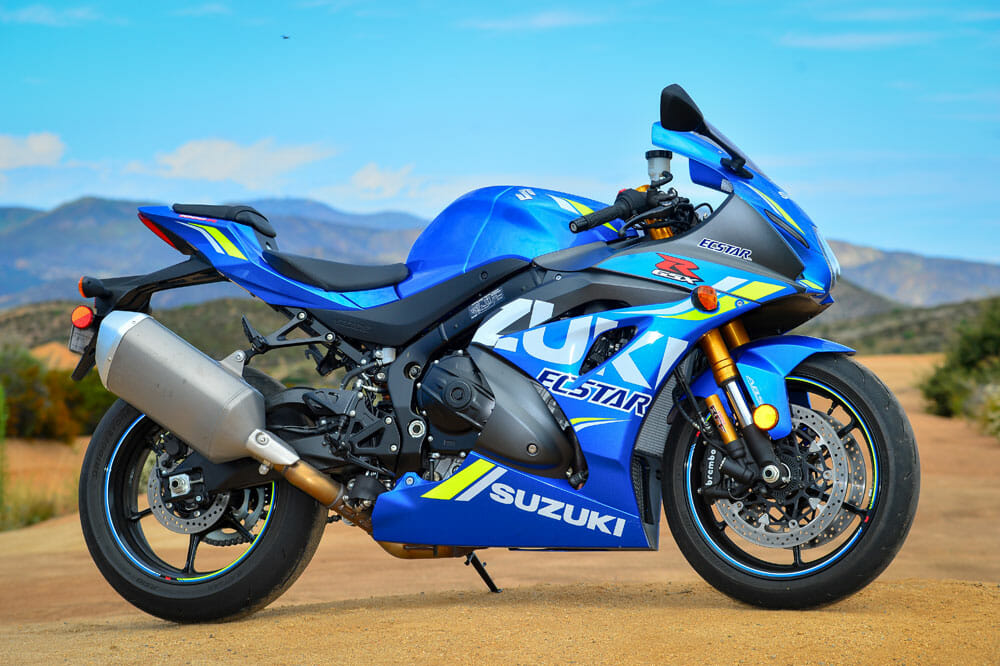
2018 Suzuki GSX-R1000 Specifications
| Engine: |
Inline 4-cylinder, 4-stroke |
| Displacement: |
999cc |
| Bore x stroke: |
76 x 55.1mm |
| Compression ratio: |
13.2:1 |
| Fuel system: |
EFI, 4 x 46mm throttle bodies |
| Exhaust: |
4-2-1 |
| Transmission: |
Six-speed cassette |
| Chassis: |
Cast aluminum twin-spar |
| Front suspension: |
43mm Showa Balance Free Fork, fully adjustable. 4.7in travel. |
| Rear suspension: |
Showa Balance Free Rear Cushion, fully adjustable. 5.3in travel. |
| Front wheel travel: |
4.7 in. |
| Rear wheel travel: |
5.3 in. |
| Front brake: |
Brembo Monobloc 4-piston, radially mounted caliper, 320mm disc |
| Rear brake: |
Nissin single-piston, fixed caliper, 240mm disc |
| Front tire: |
120/70 ZR17 |
| Rear tire: |
190/55 ZR17 |
| Rake: |
23.2 |
| Trail: |
3.7in. |
| Wheelbase: |
55.5in. |
| Seat height: |
32.5in. |
| Fuel capacity: |
4.2 gal. |
| Weight (curb, claimed): |
448 lbs. |
| Colors: |
Team Suzuki Ecstar, Glass Sparkle Black/Pearl Mira Red |